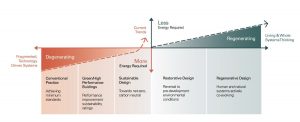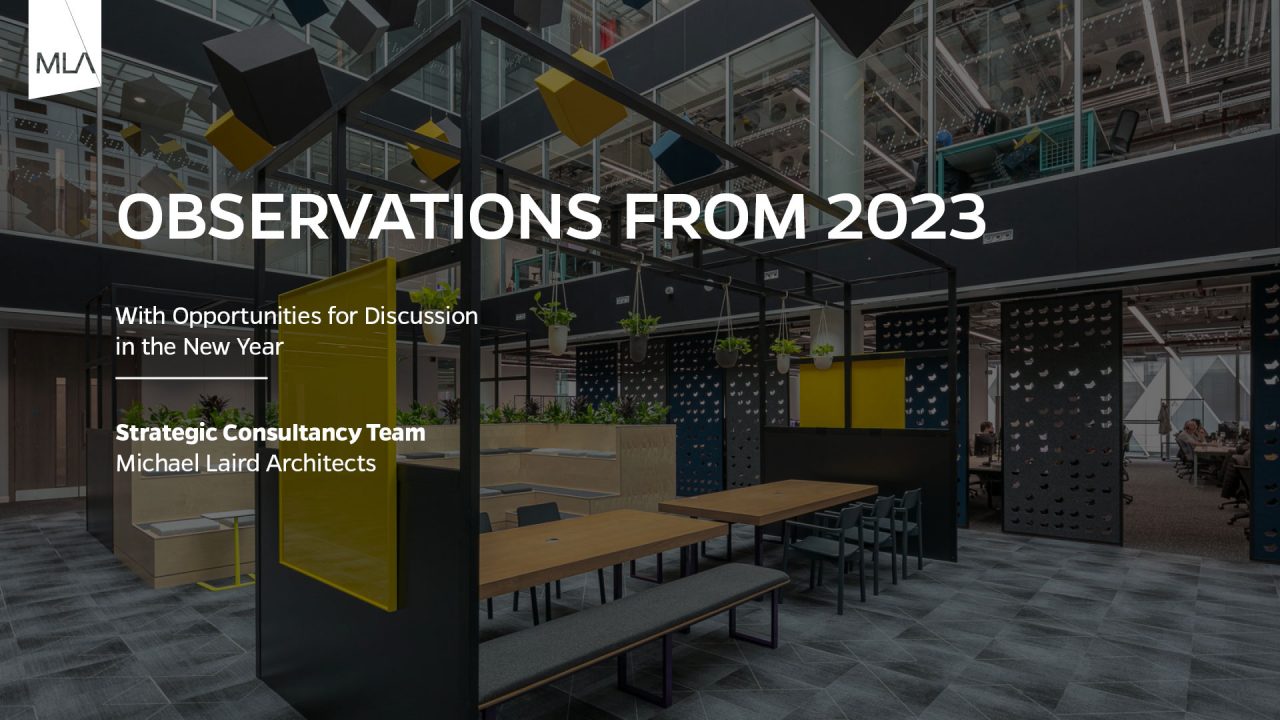Observations from 2023
With opportunities for discussion in the New Year.
On reflection, it has been a busy year for the A&D community in 2023 with lots of hard work, research, and innovation to celebrate. MLA’s consultancy team sat down to discuss what our key themes have been in 2023 and have considered some important topics for discussions to have in the new year. Read on for our key takeaways:
Hospitality & Customer Experience in the Workplace
“Hotelification” is not a new term as it was coined last year at the autumn workplace trends conference in London. We have only seen this theme take more flight within the workplace sector throughout 2023. Most of the organisations we have worked with throughout this year are considering how to enhance the workplace experience beyond the standard offer and level of building management. The office will function less as a space that staff simply ‘turn up to’ for work, it is a curated experience that is highly managed. Organisations are considering this now more than ever as they consolidate and remodel their estates, tailoring it to their customers.
Staff are no longer obligated to work only in their contracted location and therefore, the movement of people from one work location to another needs to be understood and streamlined. This requires consistent processes that enable productivity and connection. Creating a feeling for staff that they can ‘plug n’ go’ is critical to office experience, it must feel seamless. From the desk they book, the technology on their desk and in shared spaces, down to details like where they can get their next coffee hit and locating their colleagues easily. However, take care and make sure to bring staff along the journey. New spaces and ways of working require some behavioural change for staff to truly feel comfortable and to distil a sense of belonging.
Shifting Scales on Hybrid Working
In the last 4 years there have been a lot of changes in when and where people work. During the pandemic almost everyone was forced to work from home and in the easing of restrictions it was very much in the hands of the employee in deciding where they worked. Now as business demands in the private sector are increasing the employer has shifted the scales. The norm seems to be 3-days in the office with exceptions in certain organisations requiring 4-days in the office. Overall, flexibility is here to stay and will be important for providing staff with a continued sense of autonomy and choice while balancing business needs. Will hybrid working need to be defined in the future?
Beyond the current practices, there have been increasing discussions on the future of workplace when Generation Alpha enter the workforce. As stated by our very own Associate Architect & BCO Next Gen Scotland President, Sarah Lawson, at the Material Source roundtable in December, “I find it hard to say we can put a pin in whether young people want to be in the office, because the reality is that the young people who will be entering the workforce in the next six years are currently in education. We are very much on the cusp of change.”
Quiet Spaces as Critical as Collaborative Spaces
With the return to the office the emphasis at the time was (and still is) on collaboration and meaningful moments to socialise with colleagues. These buzzy spaces are incredibly important within the office landscape, but we are realising that so are highly focused or small quiet spaces. With hybrid working here to stay, having a place to take an online call is a necessity to avoid an overwhelming level of noise and disruption to all using the space. These spaces are not only important from a noise perspective but also confidentiality. Many organisations have projects or teams that require confidential space to meet or take online calls. We are seeing a rise in 1-2P “study booths” these could be individual pod products or built-in rooms that are either bookable or ad-hoc in use.
We have also seen the development of place-based tasks. Overall, collaboration is seen best placed in the office whereas focused working is best at home. However, we know that there is still a requirement for focused work in the office, especially for those that require to work in the office full-time. Therefore, individuals are demanding distraction-free working zones and spaces within the office. These quiet spaces or zones are particularly necessary for those who are neurodiverse or have social anxiety. With 15-20% of the UK population being considered neurodiverse it is critical that these individuals feel comfortable in their workplace (British Dyslexia Association, 2022).
Added Value & Amenities
Throughout the year there has been a lot of discussion on the value of purposeful shared amenity spaces to enhance the occupier and client experience. A new focus for occupiers is to understand what is provided in the base-build that they could benefit from, thus not required within their own demise.
Some common amenities provided are active travel facilities, terraces and outdoor areas, event & meeting rooms, auditoriums, wellbeing suites, shared cafes or coffee points, breakout & waiting spaces to name a few. Of these shared spaces which ones do occupiers truly value? Can the Scottish market follow the example of recent developments in Manchester, Birmingham, and London where there are a variety of good quality amenity spaces being provided by landlords to attract tenants.
Regenerative Design
One aspect of design that framed this year’s Green Month discussions at MLA was on Regenerative or “Net Positive” Design. Regenerative Design “examines how buildings and products can be designed to minimise their environmental impact and improve the health of ecosystems” (HOK’s Sean Quinn, Director of Regenerative Design). It essentially calls for “giving life to what is already depleted” (Quinn, HOK). With many new developments being built within our cities, it poses a question for occupiers and developers around the role their buildings must play in positively shaping their local environments. To be completely sustainable or Net Zero means to be “100% less bad” says Bill McDonough (RIBA Journal). We need to shift the discussion from Net Zero to Net Positive to truly make an impact within the built environment. All practitioners within the construction industry need to be better at working together to create regenerative futures. However, we can’t act in a silo, city councils, local authorities, developers, and the whole A&D community will play an important role in linking in the public realm.

Source: Bill Reed (via Architects Declare Practice Guide)
We would be delighted to hear your views and looking forward to the year ahead.
